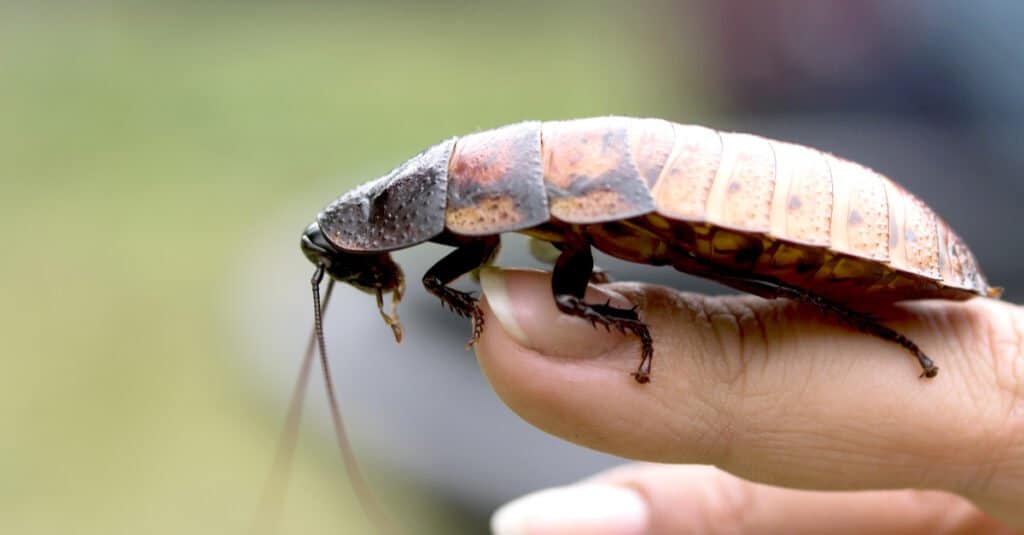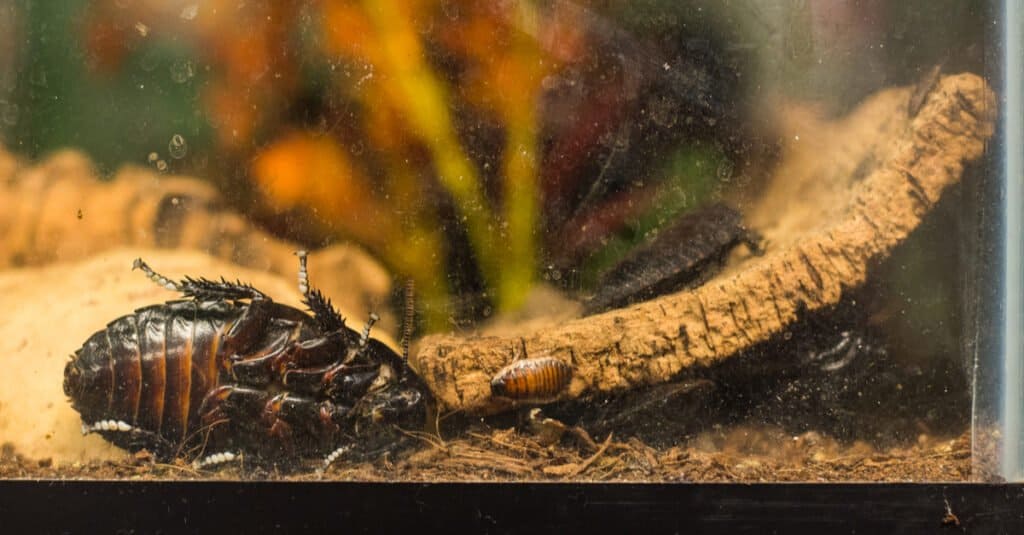With waxy, thick exoskeletons, the Madagascar hissing cockroach is one of the biggest of the species. The invertebrates are harmless but with a seriously intimidating appearance. The common cockroach is pretty small, though they can grow up between one and two inches. The hissing cockroach, upon reaching adulthood, can be twice that long as well as an inch wide.
Imagine turning on your lights seeing a bunch of those running across your floors.
Cockroaches usually communicate via pheromones. They transmit their intentions, suggestions and messages through a chemical process. Some scientists describe pheromones as agents that alter behavior, pretty much silently.

RELATED: Madagascar Hissing Cockroach Pet Guide
Such is not the case with the Madagascar hissing cockroach. It creates a sound close to that of a snake — a very loud in fact — to attract mates, to scare off other male cockroaches and to ward off predators. And these creatures can be territorial. They aggressively push, shove, stand on their toes and, yes, hiss, to dominate other males. The larger male with the strongest hiss is often the victor.
These critters are detritivores. That means the hissing cockroach chows on animal carcasses and decaying plants. That use those compounds to recycle nutrients into our ecosystems, making them critically important to rainforest health.
The natural habitat of this animal is Madagascar (surprise!). That’s an island off Africa’s eastern coast. They live among litters of leaf and in rotten logs. The animals also appreciate life near riverbanks.
But they also make beloved pets. Despite (or maybe because of) its intimidating appearance and striking hiss, the hissing cockroach has an easygoing nature and is perfect for newcomers to the insect world. They don’t move fast and they will hiss will if you touch them. But they are harmless when it comes to humans. Owners have said they’re easy to handle while being both hardy and docile.
Getting to Know the Hissing Cockroach
There are over 20 varieties of the Gromphadorhina portentosa, all in Africa. The Madagascar hissing cockroach is also known as the hissing roach or hisser. Like all roaches, they’re almost frightening climbers. A close study of their legs will show thick hairs, or small spines, which they use as anchors.
The ovoviviparous females carry their eggs in their bodies. Males have large horns and use them as shields and to protect their heads.
Unlike many of its cousins, the hissing cockroach is not viewed as a nuisance. One reason is these insects are not prone to infestation. Another distinct feature is the hisser has no wings. There is also no record of these animals carrying diseases.
But, if you chose to own one, it’s important to wash your hands after. Their bodies have a wax coating that you wouldn’t want to end up ingesting or transferring.
How These Cockroaches Hiss
The hissing cockroach has two modified spiracles. In many insects, these tubes keep the animal breathing. Our Magdascar roach uses its spiracles to create its hiss.
Hissers shove air through the tubes. They do so in a manner that can vary the hiss to:
- Attract a mate.
- React to a threat (called a “disturbance” hiss.
- To warn when one territorial hissing cockroach is about to attach another.
Appearance of the Hissing Cockroach
Physical characteristics of these roaches include an oval, shiny brown body. Unlike other roaches, they have no wings but they have the standard pair of antennae. Males are easily distinguished from females by their large horns.
Before Buying a Pet Hissing Cockroach
The Madagascar cockroach is low maintenance, entertainingly slow, clean and, finally, if raised by a kind hand, friendly. They’re inexpensive or don’t require complex (i.e., expensive) feeding or habitat requirements.
They make excellent pets for newcomers and children.
If you do decide to grab one for your household, here are a few things to keep in mind.
- Hissing cockroaches need warmth but aren’t in great need of light. Habitats should be kept between 75–85 degrees Fahrenheit.
- They need clean water. Refill the bowl on a daily basis.
- Nocturnal by nature, the tanks should have plenty of hiding spots.
- Hissing cockroaches do not live in walls or feed on garbage or sewage, which is why they don’t lean towards infestation.
- If not enclosed properly, these cockroaches will escape.
- The roaches reproduce like rabbits but only with other members of their species.
The Madagascar hissing cockroach is also an extremely inexpensive purchase. You can find out them in local pet stores and even order them online. Amazon has fast shipping with a guarantee of live arrival. If the animal arrives dead, you simply take a picture, send it via Amazon email and you get a full refund.
Legality
Florida is among several states that require any person or entity that wants to own Madagascar hissing cockroaches to get a permit. You need it even if you want to own a single animal.
Permits can specify you’re not allowed to have females, especially pregnant ones, free of their habitats. The goal is to minimize the inadvertent possibility of an invasive species into the environment.
You must be aware of your specific state’s ethics and regulations for keeping hissing cockroaches if there are any.
If the goal is to create a colony, you’re required to deal with the offspring appropriately. This means always having a reliable source of adopters or buyers before breeding.
If you are breeding, it’s recommended you start with no less than 10 roaches. You should space this out at a ratio of 1:4 (one male, four females).
It’s also considered unethical, if not illegal, to release baby hissing cockroaches into the wild. Coming from Africa, these insects do not take well to U.S. climates. They require human care that ensures they remain healthy.

How Much Does a Pet Hissing Cockroach Cost?
These are low-cost pets. We’ve found them for as little as $5 apiece. But we’ve also seen them available for around $9. It’s highly recommended you purchase hissers from breeders. That’s the only way to ensure your pets will have been bred properly. i.e., In regulated environments that carefully simulate their natural habitats
Keep in mind these animals can live up to five years. You will be responsible for them throughout that period. That includes initial purchase costs, equipment, medical expenses, etc.
Here is a small list of what you’ll need and the average cost to get it.
Tank
Keep your Madagascar cockroach in a lidded tank glass tank. It should be at least five gallons for one animal. It needs to be a tightly enclosed vessel. Roaches are escape artists and trust that if you’re breeding, they’ll get out. Cost: $30 average
Water Dish
Your pet is going to need fresh water daily. Roaches do not swim so don’t go with a bowl too deep or wide. They do float for long periods and may be able to climb out. But that’s not a chance you want to take. Cost: varies
Flooring
You can use either peat moss, mouse bedding or wood chips. You want to line the bottom of your tank with at least two inches of substrate. These floors should be periodically changed, especially in high humidity ecosystems. Cost: varies
Climbing Implements
Roaches like to climb and a block of wood, log or other “toy.” The object will give them something to do as opposed to literally climbing the walls of their enclosure. Cost: You can grab something out of the yard or at the pet store where the cost may vary.
Spray Bottle
The tank needs misting daily with water. You can pretty much repurpose any cleaned-out, non-toxic bottle. Cost: free if you recycle; up to $4 if you choose to buy
Diet
The hissing cockroach prefers a healthy diet of fresh vegetables and fruits in combination with high protein pellets. This can be a portion of dog food. The insects like romaine lettuce and other leafy greens. (But do not ever give them iceberg.) Carrots are always a nice surprise and a favorite. The creatures also nibble on apples, oranges, pea pods, squash, celery and peas. Cost: varies
Medical Expenses
There aren’t really a lot of health concerns when it comes to roaches. And it’s unlikely you’ll find a vet that’s ready to treat them. But there are matters you’ll want to keep an eye out for that we talk about further on. Cost: Pretty much none
Thermostat
Roaches need a warm environment. You’ll want a thermostat to ensure your tank’s always maintaining the animal’s 77—82 degree Fahrenheit comfort zone. Cost: $6 average
Overall, the cost to keep your cockroach happy and healthy is minimal compared to your cat or dog.
Health Issues
As stated, Madagascar hissing cockroaches are of tough stuff. Like most of this species, there aren’t many problems you need to worry about. But there are a couple of things you have to keep your eye on.
Dehydration
You need to make sure the animal gets fresh water daily. Should the roach look wrinkled or shriveled, it’s likely not getting enough agua. Signs of dehydration also include not getting those hisses at your touch.
Shedding
Child roaches will shed their exoskeleton up to a half dozen times before maturity. Roaches are vulnerable at this time. It may hide and not eat as shedding commences.
Ongoing Needs: What You Need to Care for Your Madagascar Hissing Cockroach
As roaches don’t need a lot of attention or distraction, you don’t need much to take care of them outside of what we listed above. They don’t require mental stimulation or exercise or a nice yard to run in.
Feeding Your Pet Hissing Cockroach
Most experts say your roach has access to fresh water EVERY DAY. You may come across some other source stating otherwise. We only came across one that says you only need to change the water once a week.
But that resource also suggested you only have your pet drink through a tube plugged with cotton. You’re to get these tubes from a scientific catalog and the cotton from your local grocer or pharmacy. Another post says you should keep a moist sponge in a petri dish.
Your best pet here is to get the scoop from the person selling you the pet or to do your due diligence beforehand.
How Long Will Your Hisser Live?
On average, the adult hissing cockroach will keep you company between two and five years.
The female is ovoviparous, meaning they don’t lay eggs they carry and birth live young. The life cycle has three stages: egg, nymph and adult. Nymphs pass through six molts, reaching maturity at seven months.
Where to Buy Your Pet Hissing Cockroach
You can buy these creatures in a variety of places. Check out Amazon, Petco or Chewy. Look for reputable breeders who can personally ensure the well-being of the animals.
If you order online, make sure you get a guarantee your cockroaches arrive in a timely manner (the next day is best) and that a full refund is yours if that doesn’t happen.
Special Considerations With Hissing Cockroaches
The Madagascar hissing cockroach is one of the few wingless, large roach species. While little’s known about the animal’s ecology, it’s guessed the insect lives on forest floors in rotted logs.
People find the Madagascar cockroach fascinating for its ability to produce a unique sound, especially when several animals do it at the same time. Hissing plays a role in hierarchies and courstships, but it is the “disturbance” hiss we’re most familiar with. Adults and older nymps use it when handled, threatened or disturbed. It’s a loud and recognizable sound. This “disturbance” hiss is the only one used by nymphs and females.
The male hiss does many things. It warns of threats and attracts mates. But science says it also contains information about the size of the specific insect and likely assesses the size of an opponent. The males can even distinguish the hisses of strangers.
The striking difference between the sexes is the males have large horns behind the head. Females have only small bumps. Also, the male antennae are hairy. The females are smooth. Males are terroritial, happily ramming each other with their horns.
While not known for infestation, the insects reproduce (a lot). Unless you’re a breeder, the situation can create complicated ecosystems. Pet owners may want to consider a solitary environment. It would be risky to keep two males in one tank. Yet, keeping one of each sex guarantees a populace the typical pet owner may not be prepared for.
Pet Hissing Cockroach: Price, Care, and More FAQs (Frequently Asked Questions)
How Do I Go About Buying a Hissing Cockroach?
There are plenty of places to buy hissers but your best bet is a breeder. That doesn’t mean you can’t buy one from a reputable pet store (as they may get theirs from a breeder). Be careful with online options. There’s no real way to vet their insects.
What Is a Good Price for Buying a Hissing Cockroach?
Depending on the outlet, you’re likely to spend between $5 and $10 per insect.
Can Hissing Cockroaches Fly?
No. In fact, they do not fly, sting or bite.
Can You Eat Hissing Cockroaches?
In some places, people see cockroaches high in protein. And as the insects are easily accessible, the insects make for easy meals.
What Does the Madagascar Cockroach Eat?
In captivity, these creatures eat a variety of fruits and vegetables. It’s suggested you mix the feed with high-protein dog pellets. In the wild, the roach also chows on animal carcasses and small insects.
Do Hissing Cockroaches Sleep?
They do sleep, following a special circadian rhythm. Being nocturnal, they sleep and rest during the day. Most species of cockroach runs about for at least four hours after dark. They then become essentially immobile for the remainder of the night.
Do Hissers Have a Queen?
Cockroaches don’t operate like termites and honeybees with some unique social hierarchy. Though while there are no “leaders,” males do battle over territory.
How Intelligent Are Hissing Cockroaches?
The intelligence level of the hissing cockroach is typically considered primitive. But insects tend to have a unique level of consciousness and thought. It’s believed they have the capacity to develop learned behavior.
What Thermometer Is Best for the Tank?
It doesn’t matter. You may prefer a digital version for an easier read. But you really only need a device that lets you know the tank’s temp stays in the 80 degree Fahrenheit range.
Can a Hisser Drown?
It would take a long time. A roach can hold its breath up to a half water underwater. Above water, it can do so for almost 40 minutes. Though bad swimmers, they will likely struggle to find a foothold for escape.
How Long Will a Hissing Cockroach Live Without Nourishment?
The Madgascar roach can live without food for up to 21 days and seven days without water. It’s strongly advised you not let your pet go without food or water for more than five straight days.
Thank you for reading! Have some feedback for us? Contact the AZ Animals editorial team.




